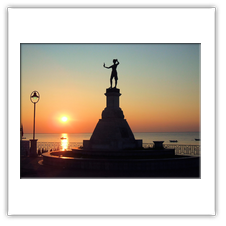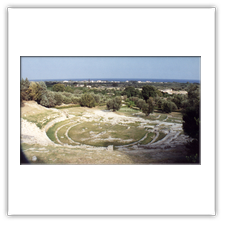Casa di Lina
Locri
PLACES TO VISIT
Locri (in Greek dialect L˛kri) is a City with 12.899 citizens in the area of Reggio Calabria. It is almoust 100 km from Reggio and is the administrative, cultural and religious center of Locride area, on the Jonio Sea in a coast called "Gelsomini Coast". It presents 5 hamlet (Baldari; Moschetta; San Fili; Merici;M'prenagatti).
Called untill 1934 "Gerace Marina", the current name derives from the old Locri Epizephiri (Magna Graecia City). Its ruins are situated in an area between the city of Locri and the town of Portigliola, few km in the South of the centre peopled.
Temple Of MarasÓ
In the first half of the V century b.C. the citizens of Locri demolished their archaic temple and rebuilt a new temple in the Ionic style. The temple was designed by Syracusan architects around 470 b.C. based on the idea of Hiero I of Siracusa.
The new temple occupies the same place as the previous one but it has a different orientation. The temple was destroyed in the eleventh century. The dimensions of the temple were 45.5 meters x 19.8 meters. The cella is free of supports on the central axes. The pronaos had two columns. The temple has 17 Ionic columns on the long side, and six on the front. The height of the temple was 12 meters.
The theater was built in the IV century b.C. not far from the ancient city, in the Contrada Pirettina, taking advantage of a hillside slope. The original structure had space for more than 4,500 people. Now only the central part of the theater is visible.
Nella prima metÓ del V sec. a.C. il tempio subý una nuova trasformazione, questa volta pi¨ radicale. La struttura originaria venne, infatti, abbattuta e si diede inizio alla costruzione di una tipologia di tempio totalmente diversa con un orientamento modificato rispetto all'edificio precedente.
Il nuovo tempio, le cui dimensioni erano maggiori di quelle del tempio arcaico (45,5 metri per il lato lungo, con 17 colonne, e 19 metri per il lato breve) venne realizzato in stile ionico mediante l'utilizzo di blocchi di calcare di ottima qualitÓ, probabilmente fatti arrivare da Siracusa. Anch'esso era esastilo-periptero e la peristasi circondava una cella con pronao ed opistodomo.

